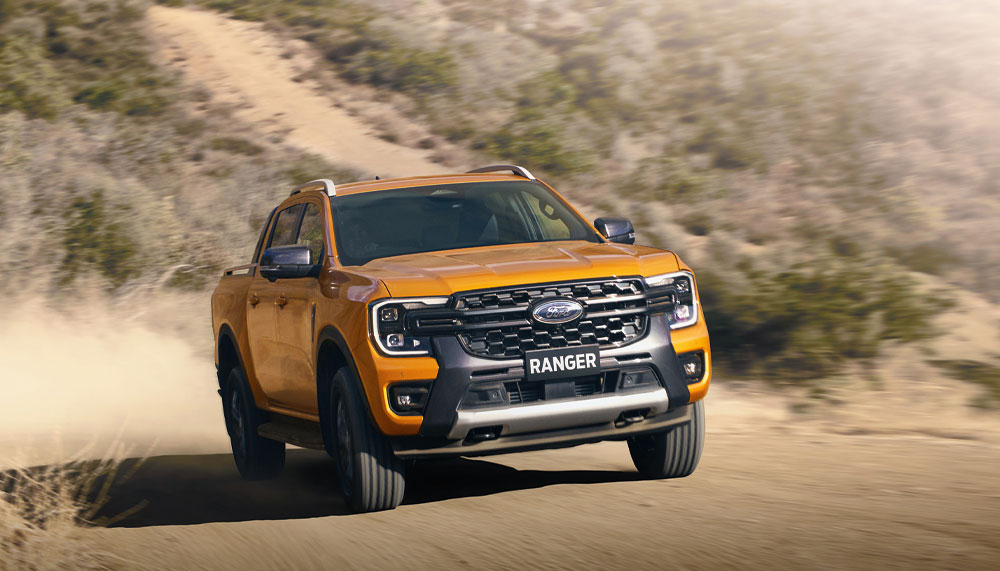These Australian-designed work and play vehicles are ahead of the competition.
Story Bruce McMahon
Ford has moved the goalposts upfield with the latest Ranger utes and Everest wagons.
It was a decent task to improve on previous Rangers, well-regarded as some of the best utility vehicles around; particularly when it came to 4WD versions. Yet, this fresh line-up is more competent and more comfortable (albeit dearer) than before. And ahead of the competition in most departments.
The 2023 Ranger, with a host of 2- and 4WD variants to consider, has undergone a complete rework, although a few carryovers remain, such as some engine and transmission options. New is the bigger and bolder body, revised suspension set-ups, an optional V6 diesel engine, plus a truckload of upgraded convenience technologies. Most of this has been driven by customer feedback and extensive testing from Birdsville to Broome.
These ladder chassis Fords sit a little wider (50mm) on a longer (50mm) wheelbase, which means extra cabin and tray space between rear wheel arches – now enough room for a standard pallet. Dual cabs with pick-up bodies score a step built into the body behind the rear wheel.
Suspension revisions include rear shock absorbers being shifted outside the leaf springs to enhance ride control. Rear disc brakes are standard from the mid-range XLT model and up.
Rangers run from XL to XLS, XLT, Sport, Wildtrak and Raptor, and are priced from $35,930 for a base 2WD with a workmanlike turbocharged 2-litre diesel engine, to $85,490 for the 4WD sport-like Raptor with its 3L, 292kW, twin-turbocharged petrol V6. The XLT is the first to offer the option of a V6 turbocharged diesel and full-time 4WD. Base models use a 6-speed automatic transmission; the rest a revised 10-speed auto. There are no manual gearboxes.
Most appealing of the options for a family workhorse could be the XLT double cab, optioned with the 184kW, turbocharged V6 diesel for around $65,000 before on-road costs. While all Rangers arrive with features from autonomous emergency braking to adaptive cruise control, locking tailgate, big infotainment screen and air conditioning, the XLT adds built-in satellite navigation, tow bar, bed liner, push-button/keyless start, rear disc brakes and alloy wheels.
Ford’s bigger ute body and energetic V6 give the XLT a power of road presence. A driver sits tall looking over a wide bonnet, but the optional 360-degree camera isn’t a bad idea for paddock work to best dodge stumps and wayward working dogs.
On the bitumen or down a bush track there’s no disguising this is a fair-sized machine and pushed hard into a turn the chassis can provoke some protest from the XLT’s 17-inch ‘all-season’ tyres. Yet, for a ute, this is an extremely relaxed machine with good road manners, handling all manner of surfaces with confidence. Ride comfort over the worst of back roads is the biggest improvement over predecessors and current rivals.
The V6 diesel is a solid performer, returning claimed averages of 8.4L/100km, which shouldn’t be too far off with a reasonable amount of highway mileage in the mix. The engine puts out 184kW and 600Nm of torque, generating a towing capacity of 3500kg. Fuel tanks carry 80L.
Transmission allows the ute to run full-time, ‘automatic’ 4WD on tarred surfaces. Gearing is great across the range, although the stubby gear lever and thumb-controlled buttons for manual shifts take some learning. Only high-flying Raptors score paddle shifters on steering wheel columns.
The extra body width is appreciated in the all-new cabin, which now has a giant centre-mounted touch screen to control information and entertainment functions. One pragmatic innovation is a USB outlet alongside the rear-view mirror for a dash cam.
Off-road this freshest crop of Rangers is more comfortable and more confident than ever, helped by clever electronics in high-end versions.
This story excerpt is from Issue #148
Outback Magazine: April/May 2023










